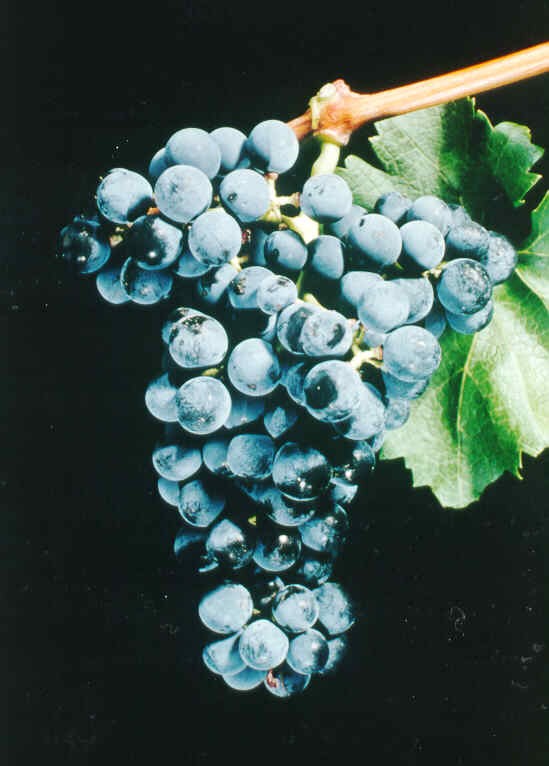Features
The name Rubienne is a variant of the word Rubient, derived from its association with colour where it represents 'purple hue' and was chosen after extensive consultation with industry representatives and marketers.
Rubienne is particularly suited to the warmer irrigated regions. It ripens at similar times to Cabernet Sauvignon at Sunraysia, Avoca and Coonawarra, and generally has higher yields.
Rubienne produces juice sugar levels that are comparable with Cabernet Sauvignon in each of the three regions.
Rubienne wine made from grapes grown in the three regions had a titratable acidity similar to or higher than Cabernet Sauvignon, a lower wine pH and a higher colour density.
Sensory evaluation of the wine from each of the three regions was carried out by experienced industry tasting panels over several seasons. Rubienne wine from each region scored equal to or slightly better than Cabernet Sauvignon.
Rubienne wine can be described as having a very deep colour, with high total and ionised anthocyanins, with plum and cherry aromas.
Rubienne wine is full bodied, having a rich, acid palate with a good tannin structure.
Wine of Rubienne is currently used commercially for blending purposes.
History
The variety Rubienne is the product of a cross between the Spanish wine variety Sumoll and the classic French variety Cabernet Sauvignon.
The original pollination was made in 1972 by the late Alan Antcliff and was granted Plant Breeder’s Rights in January 2000. A large team of people have contributed to the development of Rubienne, led by Peter Clingeleffer (viticulturist) and George Kerridge (winemaker).
The aim of the program was to produce high quality red wine grapes suited to Australian conditions. The variety was selected from a much larger population of seedlings against selection criteria including good (grape juice) sugar to acid ratios, low pH, good colour and flavour and adequate yields.
The research included an extensive evaluation of the varieties in three wine growing regions; Coonawarra (South Australia), Avoca (Central Victoria) and Sunraysia (Northern Victoria). This was followed by a period of commercial evaluation involving progressive wine companies.
Features
The name Rubienne is a variant of the word Rubient, derived from its association with colour where it represents 'purple hue' and was chosen after extensive consultation with industry representatives and marketers.
Rubienne is particularly suited to the warmer irrigated regions. It ripens at similar times to Cabernet Sauvignon at Sunraysia, Avoca and Coonawarra, and generally has higher yields.
Rubienne produces juice sugar levels that are comparable with Cabernet Sauvignon in each of the three regions.
Rubienne wine made from grapes grown in the three regions had a titratable acidity similar to or higher than Cabernet Sauvignon, a lower wine pH and a higher colour density.
Sensory evaluation of the wine from each of the three regions was carried out by experienced industry tasting panels over several seasons. Rubienne wine from each region scored equal to or slightly better than Cabernet Sauvignon.
Rubienne wine can be described as having a very deep colour, with high total and ionised anthocyanins, with plum and cherry aromas.
Rubienne wine is full bodied, having a rich, acid palate with a good tannin structure.
Wine of Rubienne is currently used commercially for blending purposes.
History
The variety Rubienne is the product of a cross between the Spanish wine variety Sumoll and the classic French variety Cabernet Sauvignon.
The original pollination was made in 1972 by the late Alan Antcliff and was granted Plant Breeder’s Rights in January 2000. A large team of people have contributed to the development of Rubienne, led by Peter Clingeleffer (viticulturist) and George Kerridge (winemaker).
The aim of the program was to produce high quality red wine grapes suited to Australian conditions. The variety was selected from a much larger population of seedlings against selection criteria including good (grape juice) sugar to acid ratios, low pH, good colour and flavour and adequate yields.
The research included an extensive evaluation of the varieties in three wine growing regions; Coonawarra (South Australia), Avoca (Central Victoria) and Sunraysia (Northern Victoria). This was followed by a period of commercial evaluation involving progressive wine companies.

